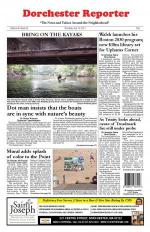January 17, 2013
The Patrick administration this week laid out a menu of transportation funding options, setting the groundwork for potential tax increases to finance improvements and expansions in a deficit-stricken system.
The governor attended his administration’s presentation and told transportation policy wonks and reporters that if no action is taken to improve the system, commuters will face longer travel times and cuts in services as fares and fees steadily increase.
At UMass Boston on Monday, Transportation Secretary Richard Davey presented a 10-year plan calling for $13 billion in capital investments that also included recommendations for ways to pay for the investments, ranging from increases in the gas tax (by 30 cents), income tax (by 0.41 percent), the sales tax (to 7.25 percent), a new a “green” fee on vehicle registrations, and fee and toll increases. Patrick said he would indicate his preferences both in his State of the Commonwealth address, which was scheduled for last night, and in his budget filing next week.
Davey noted that the MBTA’s Red Line, which runs through Dorchester, uses train cars that date to 1969. The new plan calls for $2.4 billion for new cars and improvements to the Red, Orange, and Green Lines. The cars would be built in Massachusetts, Davey said to applause from the crowd. The proposal also includes a replacement plan for aging buses, which are heavily used in Dorchester and Mattapan.
The governor’s proposal would also make available an annual $25 million in operating funds for the MBTA, with the possibility of more evening service on weekdays and a restoration of weekend service cutbacks.
Other administration priorities that were included in the presentation: the South Coast Rail commuter line, from Boston to Fall River and New Bedford, which the Patrick administration claims will create 3,800 jobs and an annual $500 million in economic development statewide; an expansion of South Station to accommodate the South Coast Rail line, Amtrak and others, and additional rush hour service; and seasonal service on weekends for Boston travelers looking to head down to Hyannis.
One administration project that was left on the cutting room floor: the so-called “Urban Ring,” which would be aimed at connecting locals to jobs out in the Route 128 area.
A number of local lawmakers said they were reviewing the various proposals. State Rep. Russell Holmes of Mattapan, who attended the roll-out at UMass Boston, said it was a “good place to start. We really need to tell people what it’s going to cost, what you’re asking for.”
Holmes said he supports an increase in the gas tax, which Patrick has previously proposed. But an increase proposal died in the Legislature and Patrick has noted the unsuccessful push whenever the topic is brought up.
Kristina Egan, the director of an advocacy group called Transportation for Massachusetts, said she was pleased to see an emphasis in the presentation on rail and rapid bus transit. Low-income residents have been “neglected,” she said.
In a statement, state Rep. Linda Dorcena Forry said a comprehensive transportation plan is needed as the country faces widespread deficits in infrastructure investments. “One project that remains a key priority for me is the long-term financing to finalize the Neponset River Greenway trail,” she said. “Not only will this completed path enable residents to access a natural gem, it will be an important alternate mode of transportation and economic driver as it draws new tourism to the district.”
Material from State House News Service was used in this report.



